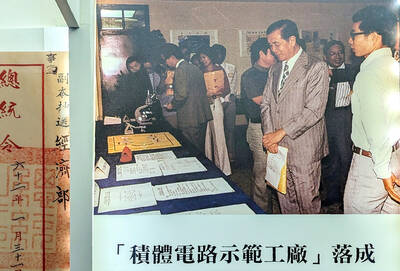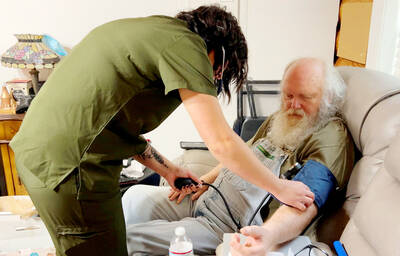As winter settles in, one of the compensations for the cold, wet weather is the beginning of the strawberry season, which is now getting into full swing. Small punnets of bright red fruit are beginning to make their appearance, prominently displayed at fruit shops around the city, or sold directly by farmers off the backs of battered blue trucks.
As the strawberry season is still young, prices are high, and for those looking to get the very best fruit, or who simply want an excuse to enjoy a rural retreat, a trip to the town of Dahu (大湖) in Miaoli County is an excellent weekend option. Some of the farms have even expanded into the guesthouse business, aiming to exploit the mountain views and bracing air of the region.
A trip to the foothills of Manabang Mountain (馬那邦山) — also widely known as Malabang Mountain (馬拉邦山) — took me into prime strawberry-growing country. An unusual feature here is the terraced fields in which the strawberries are grown, the techniques of intensive Asian agriculture having been cleverly adapted for the cultivation of this quintessentially northern European fruit. A good place to get your bearings before venturing along the tortuous and erratically sign-posted mountain roads along which many of the nicer orchards are located is the main town of Dahu, which is located slightly to the northeast of Sanyi (三義), Miaoli County and is easily accessible from the Miaoli Interchange (苗栗交流道) of the Sun Yat-sen Freeway (中山高). The importance of the strawberry to Dahu’s economy is amply signified by the huge sculpture of a bright red strawberry that stands in the center of town outside the Strawberry Museum (草莓博物館) and the Dahu Winery (大湖酒莊), which produces the region’s strawberry wine.
In addition to the ample quantities of literature available here, there is a permanent exhibition on the life cycle of the strawberry plant and a large and usually busy souvenir store that sells everything from cushions and soft toys (shaped like strawberries) to cookies and wine (made with strawberries). There is also a food court serving everything from salmon cutlets with strawberries to strawberry ice cream.
The only thing that wasn’t available at the museum was fresh strawberries, and as it was the fresh and unadorned fruit that I was after, a quick circuit of the town’s main attraction was enough before setting off for the mountains. Market stalls in the main street of Dahu certainly had strawberries for sale, but having come so far, I wasn’t going to settle for anything short of harvesting the fruit myself.
My first destination was Maple Map (楓葉地圖) a guest house set up by a family of strawberry farmers high in the foothills of Manabang Mountain, which opened early last year. The three-story concrete guesthouse with its huge picture windows and views overlooking the family’s strawberry plantation had a modern vibe, even if it was rather inexplicably decorated with driftwood and seashells, a maritime theme that would not have been out of place in Kenting (墾丁).
Maple Map looked extremely appealing at first glance, and the grassy terrace on which it was located was a delightful spot to relax, the sense of splendid isolation enhanced by the clouds that sometimes obscured the scene below — small orchards are located higgledy-piggledy all down the mountain slopes, some seemingly little more than temporary shacks, so the scene definitely benefits from a bit of soft focus.
Maple Map made for an attractive destination to spend a night, though it displayed many of the shortcomings of inexperience that is endemic in Taiwan’s guesthouse trade. For both dinner and breakfast, which were provided as part of the package, no indication was given that I was in prime fruit-growing country other than two sweet pickled plums (the plum season runs from May to July in the Manabang area) that garnished the undistinguished dinner hot pot. From my room window that morning I had seen the workers out in the mist-shrouded fields weathering a light rain as they harvested the ripe fruit. A wonderful opportunity to make the stay more memorable seemed to go begging, with the guesthouse owners apparently content to provide food designed primarily for their own convenience.
Although Maple Map does allow guests to harvest their own strawberries, given the wet weather, this was discouraged. Instead, I bought a box of strawberries that had been picked that morning, and on the drive down the mountain to visit another strawberry farm, tasted the just-picked fruit, which was indisputably delicious, and this despite the wet weather that my host at Maple Map told me would reduce the intensity of the flavor.
My next destination was the Shanding Fruit Orchard (山頂果園農場), which promised me the chance to pick strawberries whatever the weather. The farm was one of 10 to receive the Council of Agriculture’s Shennong Award (神農獎) for contributions to agriculture in 2009. The strawberries at Maple Map grew at ground level, requiring workers, or visitors intent on collecting their own strawberries, to proceed at an uncomfortable, if not exactly backbreaking, stoop. At Shanding Fruit Orchard, the plants are planted on elevated stands, allowing the fruit to be harvested in greater comfort.
At Shanding, the fruit was large and beautiful, but a taste test revealed them to be slightly less flavorsome than those from Maple Map. Wang Feng-chuan (王豊饌), executive officer of the Manabang Recreational Farm District Promotion Committee (馬那邦休閒農業園區推動委員會), said the two methods of cultivation — in the ground or elevated aboveground in racks — each had its own advantages, but that in the case of Taiwan, there is simply no substitute for altitude, and the purer water that higher altitudes provide.
Considerable effort is also being put into the commoditization of Miaoli’s strawberry harvest, and Wang was at pains to highlight the region’s most highly prized strawberry products — strawberry wine and strawberry sausages (made using strawberry wine). Grilled strawberry sausages are widely available from roadside hawkers, and the wine is an amusing tipple for the cold, damp nights in the Miaoli hills.
The strawberry season in Miaoli will be hitting its peak over the Lunar New Year, and visitors should call ahead to check that farms are open to visitors on any given day. Wang explained that farms are closed when a crop has been fully harvested or in the two or three days after pesticides have been applied. He added that virtually all farmers used pesticides of some sort, even those certified as organic, and it was all down to the type used and how its application was managed. “The plants are sprayed at key periods, but the pesticides used are now of very high quality, and they are designed to dissipate after a few days.”
Certainly at locations such as Shanding, considerable effort has been made to showcase strawberries not only at their most beautiful, but also as a healthy food choice free of contaminants. The various certifications that are proudly displayed at Shanding are something of a guarantee that environmentally and health-friendly methods are used, and while a visit to Dahu doesn’t necessarily provide the cheapest strawberries, there is a better chance of picking up some truly excellent fruit.
The strawberry season extends until April, and is followed by the plum season, which begins in May.

Oct. 27 to Nov. 2 Over a breakfast of soymilk and fried dough costing less than NT$400, seven officials and engineers agreed on a NT$400 million plan — unaware that it would mark the beginning of Taiwan’s semiconductor empire. It was a cold February morning in 1974. Gathered at the unassuming shop were Economics minister Sun Yun-hsuan (孫運璿), director-general of Transportation and Communications Kao Yu-shu (高玉樹), Industrial Technology Research Institute (ITRI) president Wang Chao-chen (王兆振), Telecommunications Laboratories director Kang Pao-huang (康寶煌), Executive Yuan secretary-general Fei Hua (費驊), director-general of Telecommunications Fang Hsien-chi (方賢齊) and Radio Corporation of America (RCA) Laboratories director Pan
The consensus on the Chinese Nationalist Party (KMT) chair race is that Cheng Li-wun (鄭麗文) ran a populist, ideological back-to-basics campaign and soundly defeated former Taipei mayor Hau Lung-bin (郝龍斌), the candidate backed by the big institutional players. Cheng tapped into a wave of popular enthusiasm within the KMT, while the institutional players’ get-out-the-vote abilities fell flat, suggesting their power has weakened significantly. Yet, a closer look at the race paints a more complicated picture, raising questions about some analysts’ conclusions, including my own. TURNOUT Here is a surprising statistic: Turnout was 130,678, or 39.46 percent of the 331,145 eligible party

The classic warmth of a good old-fashioned izakaya beckons you in, all cozy nooks and dark wood finishes, as tables order a third round and waiters sling tapas-sized bites and assorted — sometimes unidentifiable — skewered meats. But there’s a romantic hush about this Ximending (西門町) hotspot, with cocktails savored, plating elegant and never rushed and daters and diners lit by candlelight and chandelier. Each chair is mismatched and the assorted tables appear to be the fanciest picks from a nearby flea market. A naked sewing mannequin stands in a dimly lit corner, adorned with antique mirrors and draped foliage

The older you get, and the more obsessed with your health, the more it feels as if life comes down to numbers: how many more years you can expect; your lean body mass; your percentage of visceral fat; how dense your bones are; how many kilos you can squat; how long you can deadhang; how often you still do it; your levels of LDL and HDL cholesterol; your resting heart rate; your overnight blood oxygen level; how quickly you can run; how many steps you do in a day; how many hours you sleep; how fast you are shrinking; how